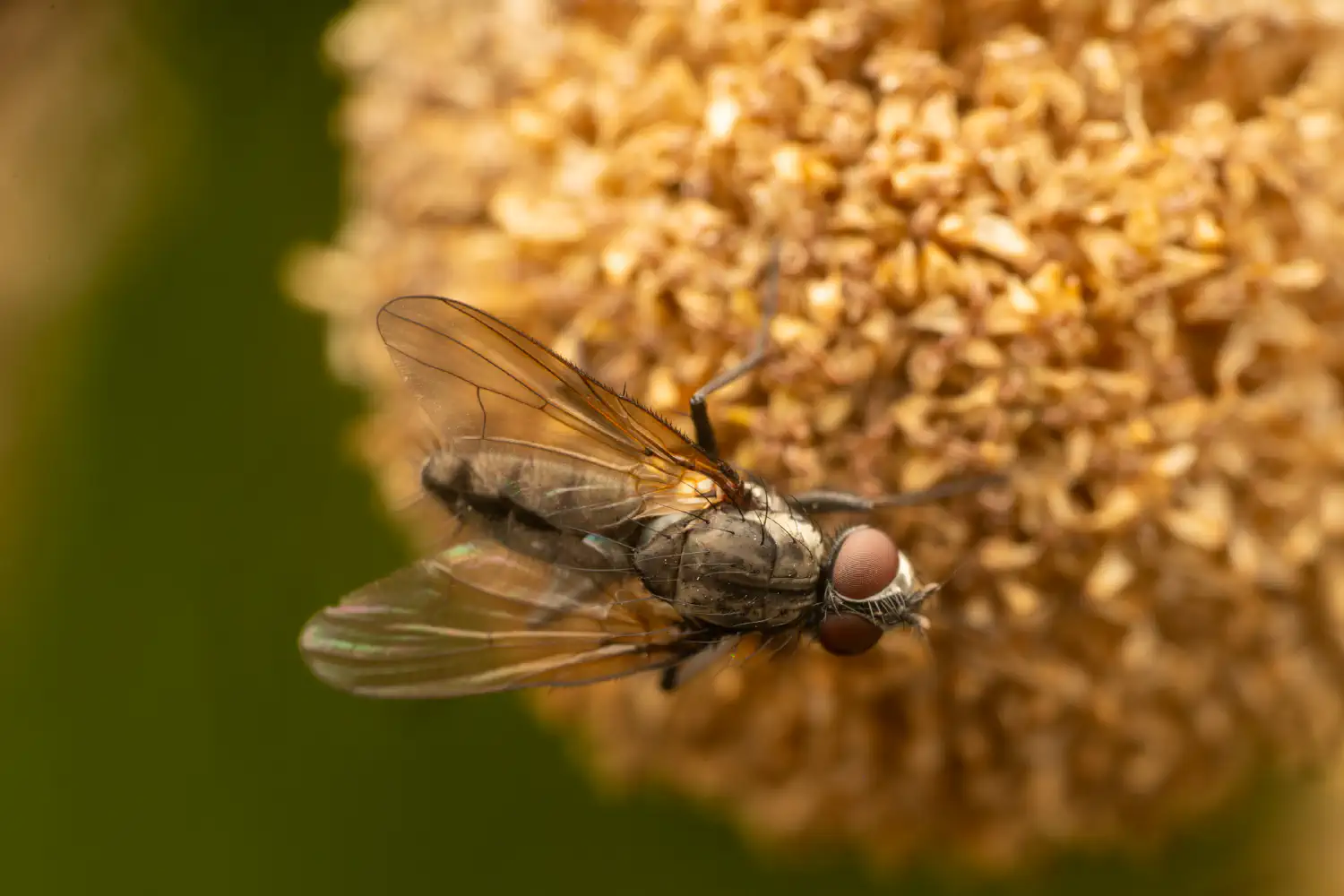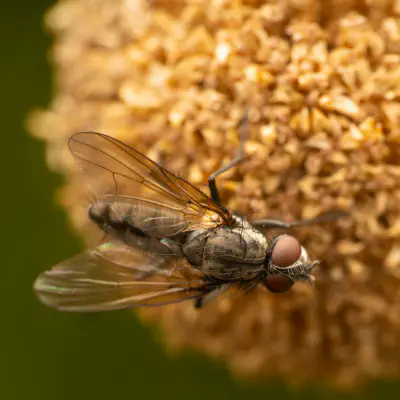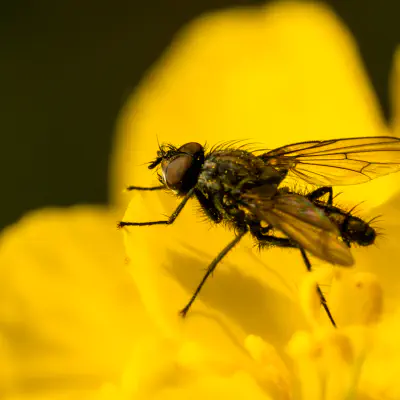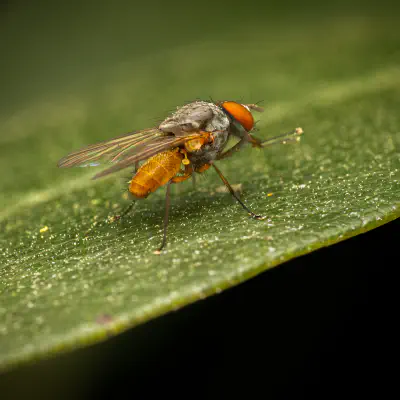Root-maggot Flies Lat. “Anthomyiidae“
The Anthomyiidae are a large and diverse family of Muscoidea flies. Most look rather like small houseflies, but are commonly drab grey. The genus Anthomyia, in contrast, is generally conspicuously patterned in black-and-white or black-and-silvery-grey. Most are difficult to identify, apart from a few groups such as the kelp flies that are conspicuous on beaches.
Hierarchy
Description
These flies are small or moderate in size. Hypopleural bristles found on the sides of the thorax are apical. The anal vein of the wing reaches the margin of the wings (except in Chelisia). The median vein is straight, not curved towards the anterior alar margin. Three pairs of postsutural dorsocentral bristles almost always are present. The first segment of the posterior tarsi are on the lower side near the base with minute bristles. The sternopleuron lower side often has short, soft hairs. Eyes in the male in most cases are close-set or contiguous. Females of many species are not known as of yet. Anthomyiidae, commonly referred to as “root-maggot flies,” exhibit small to moderate sizes and distinctive anatomical features, including hypopleural bristles on the thorax and a characteristic wing vein structure. Notably, the presence of three pairs of postsutural dorsocentral bristles is a common trait among these flies. Furthermore, the close-set or contiguous eyes in males and the limited knowledge about females in many species underscore the need for further research into Anthomyiidae biology and behavior.
Classification
Family Anthomyiidae – anthomyiid flies Subfamily Anthomyiinae Tribe Anthomyiini
Genus Anthomyia Meigen, 1803 Genus Botanophila Lioy, 1864 Genus Chiastocheta Pokorny, 1889 Genus Fucellia Robineau-Desvoidy, 1842 Genus Hylemya Robineau-Desvoidy, 1830 Genus Hylemyza Schnabl & Dziedzicki, 1911 Tribe Chirosiini Genus Chirosia Rondani, 1856 Genus Egle Robineau-Desvoidy, 1830 Genus Lasiomma Stein, 1916 Genus Strobilomyia Michelsen, 1988 Tribe Hydrophoriini Genus Acridomyia Stackelberg, 1929 Genus Adia Robineau-Desvoidy, 1830 Genus Boreophorbia Michelsen, 1987 Genus Coenosopsia Malloch, 1924 Genus Delia Robineau-Desvoidy, 1830 Genus Eustalomyia Kowarz, 1873 Genus Heterostylodes Hennig, 1967 Genus Hydrophoria Robineau-Desvoidy, 1830 Genus Leucophora Robineau-Desvoidy, 1830 Genus Paregle Schnabl, 1911 Genus Phorbia Robineau-Desvoidy, 1830 Genus Subhylemyia Ringdahl, 1933 Genus Zaphne Robineau-Desvoidy, 1830 Subfamily Pegomyinae Tribe Pegomyini Genus Alliopsis Schnabl & Dziedzicki, 1911 Genus Emmesomyia Malloch, 1917 Genus Eutrichota Kowarz, 1893 Genus Mycophaga Rondani, 1856 Genus Paradelia Ringdahl, 1933 Genus Parapegomyia Griffiths, 1984 Genus Pegomya Robineau-Desvoidy, 1830 Tribe Myopinini Genus Pegoplata Schnabl & Dziedzicki, 1911 Genus Calythea Schnabl in Schnabl & Dziedzicki, 1911 Genus Myopina Robineau-Desvoidy, 1830
See also
Pest Information Wiki
References
Wyman, J. A., Libby, J. L., & Chapman, R. K. (1977). Cabbage Maggot Management Aided by Predictions of Adult Emergence12. Journal of Economic Entomology., 70(3), 327–331. https://doi.org/10.1093/jee/70.3.327 GRISALES, D., LOPES, A. C., & DE CARVALHO, C. J. B. (2016). FAMILY ANTHOMYIIDAE. Zootaxa, 4122(1), 803–806. https://doi.org/10.11646/zootaxa.4122.1.68 Lasa, R., Córdova-García, G., Navarro-de-la-Fuente, L., & Williams, T. (2024). Sticky traps and water pan traps to monitor Delia planipalpis (Diptera: Anthomyiidae), an emerging pest of broccoli in Mexico. Crop Protection, 176, 106495-. https://doi.org/10.1016/j.cropro.2023.106495
Further reading
Genera - Suwa, M., & B. Darvas, 1998. Family Anthomyiidae. In: Contributions to a manual of Palaearctic Diptera Volume 3 (L. Papp & B. Darvas, eds.): 571–616. Science Herald, Budapest. Species - Hennig, W., 1966–1976. 63a. Anthomyiidae. In: Die Fliegen der paläarktischen Region 7(1) (Erwin Lindner, ed.): 1–974, pl. 1-78. E. Schweizerbart, Stuttgart.
External links
Family description and image Family ANTHOMYIIDAE at the Hawaii Biological Survey Leafmines of Anthomyiidae Anthomyiid Pack Diptera.info Gallery Anthomyiidae at Bug Guide Family Anthomyiidae at EOL images Morphology of important Central Europe species pdf
Ancestry Graph
Further Information
„Root-maggot Flies“ on wikipedia.org
„Root-maggot Flies“ on iNaturalist.org
Copyright

This article uses material from the Wikipedia article Anthomyiidae the free encyclopedia Wikipedia which is released under Creative Commons Attribution-ShareAlike 4.0 International License). On Wikipedia a list of authors is available.

Little beings in print
Order our calendars and books today!
Compiled with love. Printed sustainably. Experience our little beings even more vividly in print. All our publications are available for a small donation.





